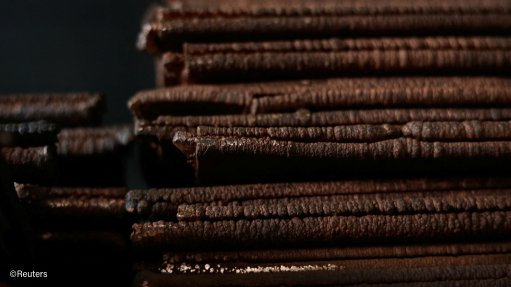A diamond in the rough, Pangolin tracks diamond-bearing kimberlites
TORONTO (miningweekly.com) – After recently announcing that it had discovered one of the largest-ever kimberlite pipes at its Tsabong North project, in Botswana, TSX-V-listed exploration junior Pangolin Diamonds is on the lookout for a partner to develop the project that is shaping up to be far larger than ever thought.
Pangolin last week announced that it had discovered a 270 ha kimberlite pipe, making it comparable with the Se251 kimberlite in Angola that measures 220 ha, the MK1 kimberlite in Botswana that measures 180 ha, and the Mwadui kimberlite in Tanzania, which measures 146 ha.
“The first thought that ran through my mind when I heard that we had indeed found a 270-ha-large kimberlite, instead of two separate pipes was: ‘We need a big partner’," Pangolin chairperson Dr Leon Daniels told Mining Weekly Online in an interview on Friday.
He quickly realised that he was in need of a big partner with financial muscle and expertise to bring such a potentially large project to production.
Daniels comes from a family deeply involved with searching for diamonds, as his great grandfather had some claims at Kimberley’s Big Hole, in South Africa.
Speaking from his cattle farm in Uruguay, Daniels recounted a fond youthful memory of his family gathering on Sunday afternoons on their Bellsbank claims, in the Northern Cape province, where they would begiven diamonds weighing under a quarter of a carat to play with, which his folks at that time deemed to be nearly worthless.
At the age of 16 Daniels operated his first rotary pan on those claims and recovered his first own diamonds. At the age of 21, he discovered his first kimberlite.
Daniels, a South African native, studied under Dr John Gurney, in Cape Town, where he earned his PhD, and assisted Gurney to develop the G10-indicator matrix, by collecting the majority of the samples to populate Gurney’s database.
His career began in Botswana, working under Chris Jennings at the M1 kimberlite, in the Tsabong kimberlite field, for Falconbridge in the 1970s, and he had spent most of his career in that country.
Daniels, one of the world's foremost diamond exploration geologists, and specifically in Botswana, had also cofounded African Diamonds, that was subsequently bought by Vancouver-based Lucara Diamonds in 2010, for $100-million.
Daniels said he became convinced that in-between diamond major De Beers’ exploration activities and discoveries to the north of the Tsabong North project, and that of Falconbridge (which was eventually bought out by De Beers) to the south of Tsabong North, there had to be significant potential for new kimberlite discoveries.
He subsequently staked several claims and was in October 2008 awarded exploration licences for the Tsabong North project.
“Coincidentally, this coincided with the global market crash of 2008, and we thought to ourselves that we’ll undertake two trenches to take samples, and if it turns out that there are no significant concentrations of indicator minerals, we’ll just relinquish the licences and move on,” he said.
However, as it turned out, among the samples taken, Daniels had found one sample that contained more indicator minerals than any other sample he had ever come across, save for samples from the Orapa kimberlite, which today is the largest openpit diamond mine in the world.
Diamond-indicator minerals include mantle-derived garnets that had formed millions of year ago under extreme pressure deep within the earth’s crust.
The company is now preparing to step up its exploration efforts at the Tsabong North deposit, which lies about 35 m below the surface. Pending joining forces with a partner, Pangolin would undertake more intensive tests in the field next year, that could result in a bulk-sampling programme, which could give the first indications of what grades the giant kimberlite might hold.
Pangolin also last week revealed that it had unearthed another kimberlite – the Martin 01 – at the Tsabong North project.
The TSX-V-listed prospector said a single hole drilled into the magnetic target revealed a potentially 31 ha Martin 01 kimberlite, which is located about 12 km north of the 270 ha Magi kimberlite.
Pangolin said it had intersected crater facies volcanic sediments at 85 m below the surface, and sandy tuffs at a depth of 105 m.
POOR COUSIN
However, significant as the Tsabong North discovery might turn out to be, it is just one of four properties under the explorer’s lens in Botswana.
Pangolin might be on to the trail of another much smaller, yet nearer-term mineable kimberlite at its Mmadinare project, in the north-east of the country.
“It’s quite clear that the geology has been significantly altered, and we have found indicator minerals from the lower mantle, that was probably formed a billion years ago,” he said.
The prospector recently reported that an independent laboratory analysis by CF Mineral Laboratories of Kelowna, British Columbia, had returned five manganese-rich, or Mn-ilmenites, from 20 kg of material taken from a discovery pit at a 2 m depth, in the central part of the intrusion.
The five Mn-ilmenites, which were discovered through pitting from surface, were similar to ilmenites reported by Dr Felix Kaminsky and co-workers from 2001 to 2009 as inclusions in diamonds and from diamondiferous kimberlites in the Juina area, of Mato Grosso, Brazil.
Daniels said those ilmenites were derived from the lower mantle of the earth and are important diamond indicator minerals.
The Juina area had economical kimberlites containing type IIa pink diamonds, as reported by explorer Diagem in 2007 and 2008.
Pangolin also said enzyme-leach trace element results from the ilmenites, identified by an independent analysis of material sent to Activation Laboratories, in Ancaster, Ontario, were consistent with orientation trace element results over known diamondiferous kimberlites in the Jwaneng kimberlite field.
The company added that multiple diamond-inclusion type Mn-ilmenites were also recovered from soil samples collected in a different part of the project area.
Daniels said exploration work was currently in progress on site, with the team excavating trenches to delineate the surface area. The team would dig at least three exploration pits to a minimum depth of 5 m and process at least 100 t of material through Pangolin's dense media separation plant.
The concentrate would then be sent to an independent laboratory for the possible recovery of macro-diamonds. Sampling would be conducted to locate the source of the Mn-ilmenites recovered from stream sediment soil samples.
Daniels noted that owing to the deposit being situated virtually at the surface, and bearing in mind that the Marsfontein diamond mine is situated virtually just opposite the border, in South Africa’s Limpopo province, this project could very well turn out to be Marsfontein’s ‘poor cousin’, that could relatively easily be developed into a small revenue-earning diamond mine for the company.
THE MISSING ORAPA ALLUVIAL DIAMONDS
Daniels told Mining Weekly Online that of all the Botswana projects he had worked on in his career, the Malatswae project, in the north-east of Botswana had become his pet project.
Being completely different from any of other Botswana kimberlites, owing to the presence of a ferrocrete layer just below surface that had been found to destroy tell-tale indicator minerals, made finding a kimberlite much more arduous.
The project could be divided into a northern ilmenite-rich segment, and the southern alluvial segment, and it is here where Daniels said he was looking for the missing alluvial diamonds from the Orapa diamond field, situated about 100 km to the north-west.
Daniels said he planned to have drills in the ground before year-end, to see if they can find an ancient pothole in the sandstone, which could contain a treasure trove of high-value diamonds.
Pangolin recently said it had completed ten down-the-hole percussion-hammer drill holes at Malatswae, to a depth of 130 m.
The company sent the drill chips to an independent laboratory for analysis and for recovering any indicator garnets and diamonds. Results were still pending.
"The history of the kimberlitic garnets in the Malatswae project is complex. Their chemistry strongly suggests that there is an undiscovered kimberlite source within the project area and we intend to make the discovery. The completed drill programme will assist us towards that goal,” Daniels said.
The results from the analysis would help to determine the second phase of drilling in this area.
Previous work at the project had revealed several similarities with miner Petra Diamonds’ nearby KX36 kimberlite, which included similar concentrations of indicator garnets from soil samples and aeromagnetic positive and negative anomalies, similar to those of the KX36 kimberlite, but in this case, with a surface area of about 5 ha.
Significant concentrations of mantle-derived garnets were also previously recovered from sampling, including G10 garnets, of which the chemistry confirmed a new kimberlite source was present in the area, rather than from the Orapa kimberlite field.
Pangolin’s fourth target is the Jwaneng South project, which is 799 km2 in size and situated on the Archaean Kaapvaal Craton. It is located 50 km south of the De Beers’ Jwaneng mine, the richest diamond mine in the world by value.
Daniels said a detailed aeromagnetic and radiometric survey had been completed over the project area, which identified multiple large aeromagnetic anomalies commonly associated with kimberlites.
A ground gravity survey was also completed over the GK6 target, which is associated with a well-defined geobotanical anomaly with a diameter of 1.4 km, an aeromagnetic anomaly, anomalous trace elements and an isolated gravity low.
Comments
Press Office
Announcements
What's On
Subscribe to improve your user experience...
Option 1 (equivalent of R125 a month):
Receive a weekly copy of Creamer Media's Engineering News & Mining Weekly magazine
(print copy for those in South Africa and e-magazine for those outside of South Africa)
Receive daily email newsletters
Access to full search results
Access archive of magazine back copies
Access to Projects in Progress
Access to ONE Research Report of your choice in PDF format
Option 2 (equivalent of R375 a month):
All benefits from Option 1
PLUS
Access to Creamer Media's Research Channel Africa for ALL Research Reports, in PDF format, on various industrial and mining sectors
including Electricity; Water; Energy Transition; Hydrogen; Roads, Rail and Ports; Coal; Gold; Platinum; Battery Metals; etc.
Already a subscriber?
Forgotten your password?
Receive weekly copy of Creamer Media's Engineering News & Mining Weekly magazine (print copy for those in South Africa and e-magazine for those outside of South Africa)
➕
Recieve daily email newsletters
➕
Access to full search results
➕
Access archive of magazine back copies
➕
Access to Projects in Progress
➕
Access to ONE Research Report of your choice in PDF format
RESEARCH CHANNEL AFRICA
R4500 (equivalent of R375 a month)
SUBSCRIBEAll benefits from Option 1
➕
Access to Creamer Media's Research Channel Africa for ALL Research Reports on various industrial and mining sectors, in PDF format, including on:
Electricity
➕
Water
➕
Energy Transition
➕
Hydrogen
➕
Roads, Rail and Ports
➕
Coal
➕
Gold
➕
Platinum
➕
Battery Metals
➕
etc.
Receive all benefits from Option 1 or Option 2 delivered to numerous people at your company
➕
Multiple User names and Passwords for simultaneous log-ins
➕
Intranet integration access to all in your organisation


















